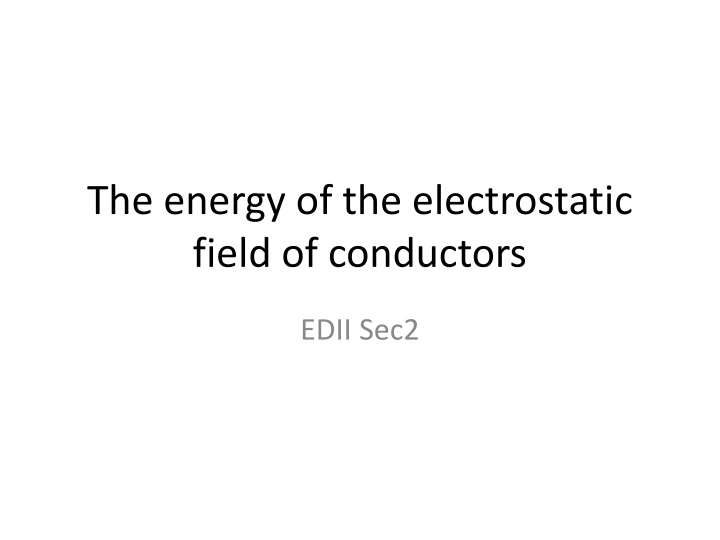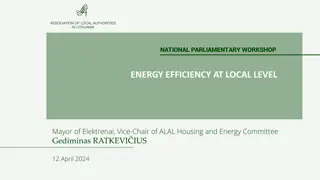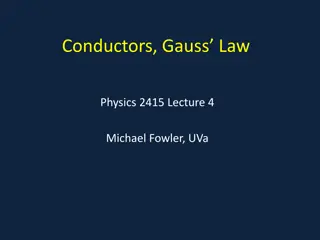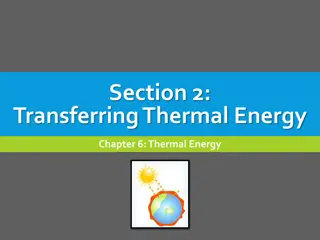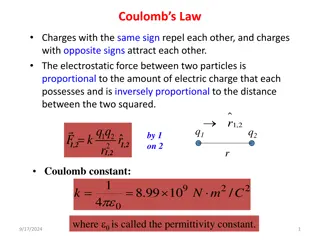Electrostatic Field Energy of Conductors
The energy of the electrostatic field of conductors and how it changes with varying charges. Exploring the linear relation between field equations in vacuum, capacity coefficients, and the impact of charge variations on conductor surfaces.
Download Presentation

Please find below an Image/Link to download the presentation.
The content on the website is provided AS IS for your information and personal use only. It may not be sold, licensed, or shared on other websites without obtaining consent from the author.If you encounter any issues during the download, it is possible that the publisher has removed the file from their server.
You are allowed to download the files provided on this website for personal or commercial use, subject to the condition that they are used lawfully. All files are the property of their respective owners.
The content on the website is provided AS IS for your information and personal use only. It may not be sold, licensed, or shared on other websites without obtaining consent from the author.
E N D
Presentation Transcript
The energy of the electrostatic field of conductors EDII Sec2
1. The total energy of the electrostatic field of charged conductors is This ignores the internal energy of the conductor where E = 0, but where the microscopic field e is non-zero.
Since = 0 in vacuum Boundary surface = surface of conductors + infinitely remote surface E = 0 here Surface of conductors
df is inward Surface of conductors Normal component of E (the only one) is outward from the conductor opposite to the outward normal of the region of integration Sign change Potential is constant on each conductor since Same expression as for system of point charges
2. ea and a are related. Because the field equations in vacuum are linear and homogeneous, the relation is linear. Integral-differential operator Normal is outward from conductor again The most general linear relation can be written Depends on geometry of problem Units: length ( = e/r)
Caa= capacity coefficients Ca b= electrostatic induction coefficients A potential b on conductor b induces a charge ea on conductor a Single conductor C = Capacity magnitude of C = linear dimension of the conductor The converse relations are C-1ab = inverse of matrix Cab
3. How does the energy change when we vary the charges on the conductors? All space outside of conductors. (E=0 inside) Div of change in field = 0 since = 0 still in vacuum Conductor surface + infinite surface (where E = 0)
Field is outward from the conductor while df is inward Surface of ath conductor = Sum over conductors of the work needed to bring a small charge ea from infinity where = 0 to conductor a at potential a.
4. How does the energy change when we vary the potentials on the conductors? By similar arguments = Sum over conductors of the work needed to change potentials by a on conductor a with given charge ea.
5. Differential relations and the symmetry of the C matrix Order of partial differentiation doesn t matter, so
6. Both quadratic forms must be positive since is positive definite. This condition leads to two inequalities for the coefficients of capacitance
Proof: Consider two conductors. The coefficients Cab depend only on geometry 1. Might be positive or negative depending on the relative sign of e1 and e2. 2. Needs to be positive, regardless of the relative signs and sizes of e1 & e2. Generally, for any number of conductors, similarly i.e. capacity coefficients are positive
7. Electrostatic induction coefficients are negative All Proof. Ground all conductors except the ath. Sign of induced charge must be opposite that of the inducing potential Therefore Cba < 0. Negative charge is drawn up from ground by attraction of positive voltage on conductor a
Since can have no minimum in vacuum, > 0 in all space. The minimum value of (zero) appears on conductor b. Since d /dn > 0 we have < 0. b b
8. The energy of the electrostatic field of conductors has an extremum property, called Thomson s Theorem. The energy of the actual field is We can extend this integral over all space including volume of the conductors, since electrostatic field is zero there. Now allow charges to penetrate infinitesimally into the conductors, without changing the total charge on them. How does the energy change?
The change in energy due to the redistribution of charge <>r is Vol. of conductor only is the potential of the actual field, i.e. = constant inside the conductors.
9. Thomsons Theorem. The energy of the actual electrostatic field is a minimum relative to the energy for any other distribution of charges on the conductors.
10. Consequence of Thomsons theorem: An uncharged conductor inserted into a system of charged conductors is attracted to those conductors. This fictitious field supposes that no charge is induced on the conductor surface to screen its interior. It is the same field as before the conductor was inserted. By Thomson s theorem, the energy of the shown fictitious field is not a minimum The actual field. The energy of the actual field is a minimum by Thomson s Theorem. It is lower than for the previous field shown. The inserted conductor alters the field and lowers its energy. An uncharged conductor is attracted to any system of charges.
11. A conductor, charged or uncharged, cannot be in stable equilibrium under electric forces alone. Proof: Combines theorem that point charge cannot be in stable equilibrium in an electrostatic field and Thomson s theorem No way to trap a conductor in an electrostatic bottle
12. Energy of an uncharged conductor in a uniform external field Uncharged conductor in the field of a distant point charge. The field that would be if the conductor were not there is The - is due to the chosen direction of r - er/r3 This field is uniform over the volume of the conductor Remote charge e An electric dipole moment is induced The energy of interaction = the energy of the conductor in the external field of e = the energy of e in the field of the conductor. Potential at e due to the conductor is a dipole field = Dipole moment of conductor that is Field from e thatwould be
13. Since field equations are linear, components of are linear functions of Polarizability tensor. Depends on shape of conductor. Symmetric. Coefficients are proportional to the volume of the conductor Energy of a conductor in an external field Double sum
